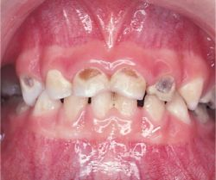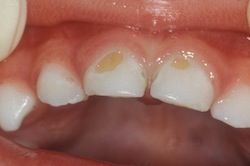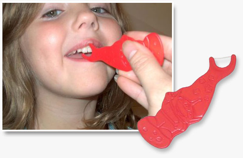
Early childhood tooth decay (also known as early childhood caries) is a severe form of cavities which can develop in young children. Early childhood caries has been a serious public health problem for many years, and is prevalent in low socioeconomic groups and the general population. As pediatric dentists, it is our responsibility to implement preventive practices that can decrease a child’s risk of developing this dental disease.
Good oral health practices should start at the time the first tooth erupts. Cavities can develop in young children for many reasons.
Things to consider once your child starts teething (and even before!):
Do you and any other caregivers regularly visit the dentist?
Cavities are an infectious disease. Transmission of the bacteria causing cavities can happen from caregiver to child. The most common way infants acquire this bacteria is through inoculation of their mother’s saliva. Infants whose mothers have untreated cavities are at a higher risk of transmitting these cavity-causing bacteria. Eliminating saliva-sharing activities such as sharing utensils, orally cleaning a pacifier, etc) can help decrease an infant/toddlers chance of acquiring these cavity-causing bacteria. Ideally, the mother should visit the dentist during the prenatal period to optimize her oral health prior to her baby’s arrival.
What goes in your child’s bottle/sippy cup/regular cup?

Another risk factor for developing cavities is the child’s dietary habits. Dietary habits begin to develop around 12 months of age and are maintained throughout early childhood. Frequent bottle feeding at night, breast-feeding ad libitum, and extended/repetitive use of the no-spill sippy cup are associated with early childhood cavities. Early childhood cavities may not arise from breastmilk alone, but breastmilk combined with other carbohydrates has been found to be a cause in the development of cavities.
Frequent consumption of between-meal snacks and beverages containing sugars (for example: juice, milk, formula, soda) increases the risk of cavities due to prolonged contact between the sugars and bacteria on the baby teeth. The American Academy of Pediatrics recommends one cup of fruit juice per day for children ages 1-6. It’s better to have the juice out of a regular cup and as part of a meal so that the sugar does not have prolonged contact with the baby teeth.
Does your child go to bed with a bottle/sippy cup?
Going to bed with a bottle filled with milk or formula allows bacteria in your child’s mouth to take the sugars and form cavities on the baby teeth. If your child currently goes to bed with the bottle, the transition to going to bed without the bottle will be hard. Start by trying to put your child to bed with a bottle filled with just water then gradually wean them off the bottle.
Is your child over 1 and still drinking from the bottle/sippy cup?
The American Academy of Pediatrics and American Academy of Pediatric Dentistry recommends weaning your child off the bottle/sippy cup by age one. This is to encourage your child to get most of their nutrients from solid foods and to prevent early childhood cavities. You would be amazed at how much easier it is to wean a child from the bottle/sippy cup at age one rather than waiting until they are 2 or 3!
Is your child brushing at least 2x/day? Are you helping your child brush/floss his/her teeth?

Children may need timers (hourglass timers), music, or electric toothbrushes with timers to encourage the child to brush for the recommended two minutes. Some children have nice spacing in between their back baby teeth but some children’s back teeth are close together/touching. If this is the case, you will need to floss in between your child’s back teeth to prevent cavities in the areas where a toothbrush can’t reach. Using regular floss can be hard for parents to wrap around their fingers and reach in the back of their child’s mouth therefore, these flossers can make the job a lot easier!
Children are at varying levels of risk for developing caries throughout life. In order to be successful at preventing dental disease, dentists should begin preventive interventions within the first year of life. This age 1 dental visit allows the dentist help parents identify behaviors which may lead to future tooth decay. Finding a dentist at age one also allows the family to have a dentist on hand in case of an emergency, and helps the child acclimate to the dental office environment.


